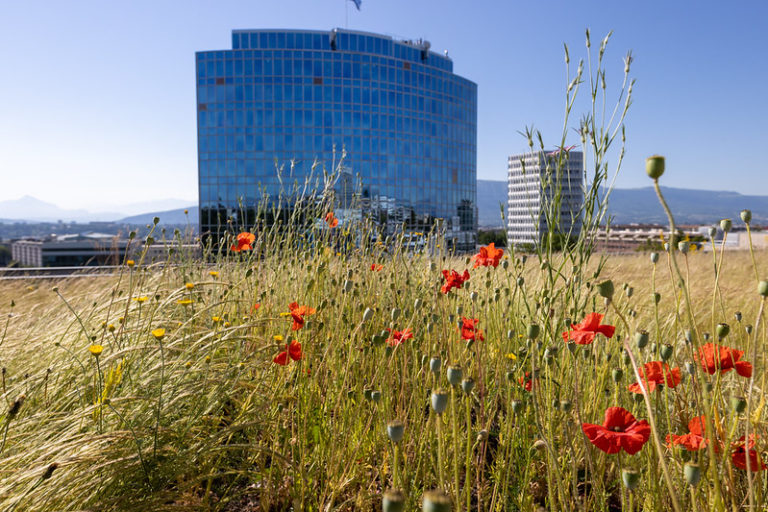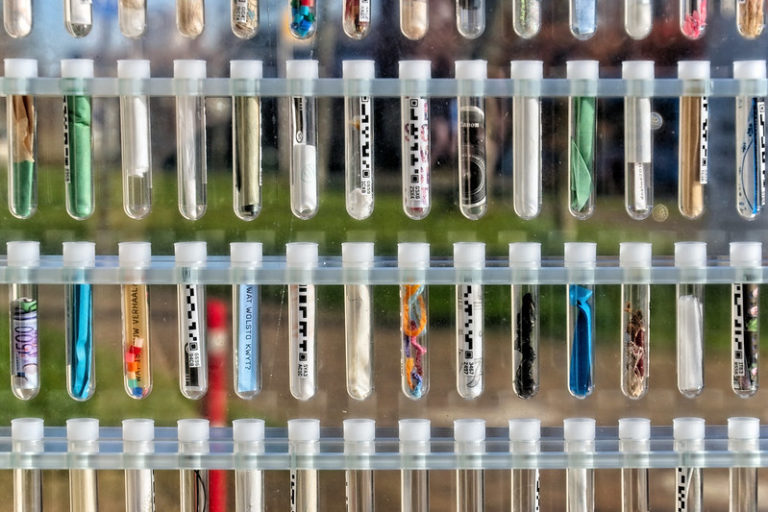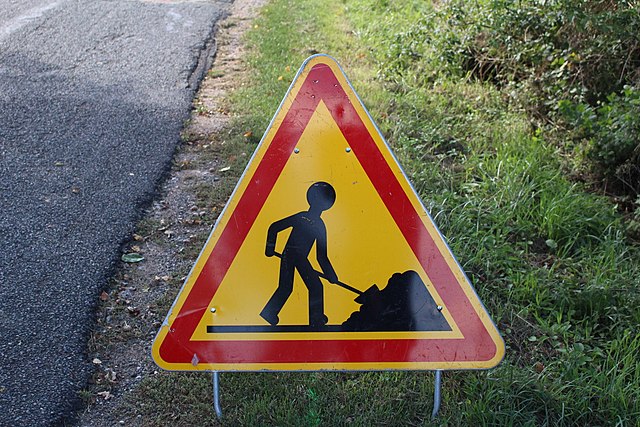News
Pro-GMO multinationals indirectly manage the Svalbard seed bank
The Svalbard Global Seed Vault (Svalbard, Norway), often nicknamed the “seed vault“, plays a special role in preserving genetic biodiversity. Its main mission, focused on the long-term conservation of seed samples, is officially to preserve the diversity of plant genetic resources and ensure their accessibility in the event of disasters. However, a closer look at how it works reveals the considerable influence and interests of pro-GMO players in its governance. Who will really benefit from Svalbard, the multinationals or the farmers?
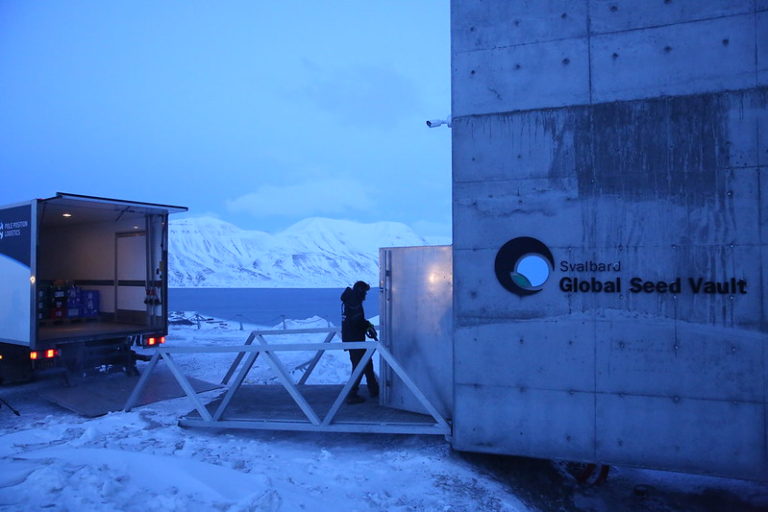
On 22 October, the Svalbard Global Seed Vault (Svalbard, Norway) welcomed over 30,000 new seed samples from 21 countries. This news provides an opportunity to revisit the sometimes controversial workings of this global seed vault located on the island of Spitsbergen, halfway between Norway and the North Pole. This geographical location was chosen for the conditions required for long-term seed conservation. Opened in 2008, Svalbard’s official aim is to preserve millions of seed samples from a very large number of crop species and to ensure that they are available to those who supplied them in the event of natural or man-made disasters. For example, Icarda, which used to manage the Syrian seed bank, recovered samples that it had deposited in Svalbard in 2011 following the military conflicts that had threatened them, and sent them to Morocco and Lebanon, where it transferred its research activities in 2015i.
Functioning and governance of Svalbard
Svalbard operates under a tripartite agreement between the Norwegian government, the Nordic Centre for Genetic Resources (NordGen) and the Crop Trust, a private organisation comprising governments, foundations and private companies forming a “Donor Council” (see diagram below). Although Norway owns the Seed Vault, the building housing the collections, funding and assistance with day-to-day operations are provided by the Crop Trustii, while NordGen manages the repository database.
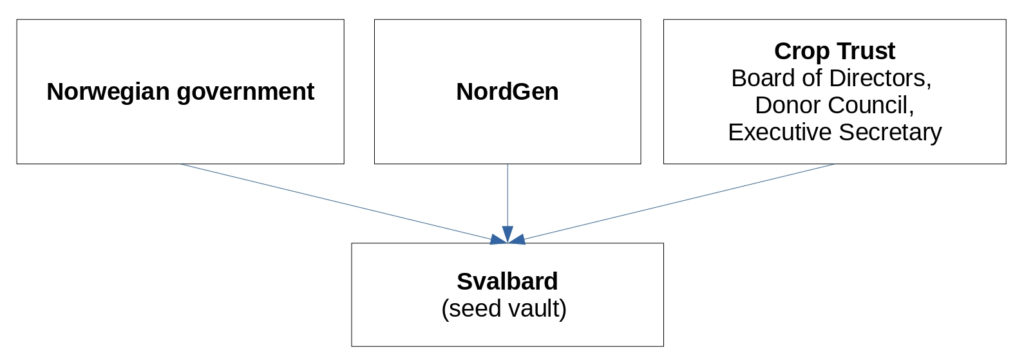
The seeds are deposited voluntarily by the collection managers according to a “black box” principle, i.e. they remain the property of the depositors and only they can access and share them. This “duplicate” of the seeds deposited at Svalbard is therefore intended as a safeguard. Svalbard only accepts seeds that are shared in accordance with the rules of the multilateral system or article 15 of the ITPGRFAiii or, as mentioned above, seeds from the depositing country, which must be the place of origin of the seeds it wishes to deposit. Genetically modified (GM) seeds cannot be deposited in Svalbard. As Crop Life points out, Norwegian legislation currently prohibits the import and storage of GM seeds on its territoryiv . These rules are designed to ensure that saved seeds comply with international agreements on biodiversity and food safety.
On paper, the seeds deposited in Svalbard can only be returned to the depositors. The depositors can then agree to share the seeds in accordance with article 12 of the ITPGRFA. This involves the signing of Material Transfer Agreements (MTAs) including provisions on intellectual property and benefit sharing, which are supposed to protect the States, the depositors and, possibly, the farmers supplying the seeds and, in this case too, to remunerate themv. Despite these provisions, players such as the farmers’ union Via Campesina claim that these MTAs give private companies access to seeds collected from farmers’ fields. They can then use them to develop new varieties covered by intellectual property rights. This infringes farmers’ rights to use their own seeds, without sharing the benefits vi . In addition to this potential facilitation of biopiracy, the governance of Svalbard also raises questions.
Influence of pro-GMO players
The Crop Trust, which plays a central role in the financial and operational management of Svalbard, includes a number of members who advocate pro-GMO agriculture. For example, the Chair of the Crop Trust’s Board of Directors, Catherine Bertini, has been associated with the Bill and Melinda Gates Foundation, known for its support for GMOs. Jean-Christophe Gouache, who has held senior positions at Limagrain, a French champion of GMO development, is another influential executive member.
Donors to the Crop Trust (“Donor Council“) include agrochemical multinationals, such as Dupont-Pioneer, Syngenta and Bayer, involved in GMO production. This strong presence of industrial interests within the Crop Trust makes it a pressure point influencing seed conservation and access policies, and potentially favouring projects aligned with the commercial interests of these multinationals.
What is particularly noteworthy is the lack of direct representation of farmers, despite the fact that they are the main suppliers of seeds, within the governance of an institution such as the Crop Trust. Organisations are also pointing to the risks of inequity and loss of sovereignty for local farming communities. This represents a violation of farmers’ right to seeds (guaranteed by article 9 of the ITPGRFA), as well as the dangers of biopiracy and excessive commercial influence. When Svalbard was set up in 2008, Via Campesina’s message to the seed multinationals was unequivocal: “Whether through patents, plant breeders’ rights or GMOs, the aim of the seed multinationals is to impose their right of ownership on all existing seeds, by eliminating most of the cultivated biodiversity that could compete with them. Is it because they intend to carry out their project to totally wipe out all the biodiversity cultivated in the fields that they are today financing the storage of seeds stolen from farmers and Indigenous Peoples in the Svalbard gene bank“?viii.
Possible impact on conservation policies
The influence of agrochemical multinationals creates a risk of conservation policies being biased. Although Svalbard is intended to conserve non-GMO seeds, pro-GMO donors can exert pressure to align conservation policies with their interests, for example by limiting access to certain seeds and favouring the conservation of seeds resistant to herbicides marketed by these multinationals. The risk of decisions going against the interests of local farming communities, the peasant seed system and conservation initiatives based on traditional seeds cannot therefore be totally ruled out. Yet it is one of Svalbard’s stated missions to protect these farmers’ access to this diversity.
However, it is worth asking whether this issue of conservation should not be reconsidered in the light of the digitisation and dematerialisation of seeds. In addition, the emergence of “new GMOs“, presented as non-traceable because they are “identical” to traditional seeds and could be excluded from the official category of GMOs in the EU, accentuates this questioning.
The significant inequality of financial support between Svalbard and ITPGRFA is a worrying development in the field of conservation. Svalbard has received substantial funding (around 30 million dollars [23 million euros] spread over 6 years starting in 2007) from the Bill and Melinda Gates Foundation. The ITPGRFA Benefit Sharing Fund (BSF), designed to support the collection and conservation of plant genetic resources in the fields and in the national banks of developing countries, does not receive the same level of financial support. In May 2023, ITPGRFA’s secretary, Kent Nnadozie, announced that contributions from donors, which do not include the Gates Foundation, totaled $11 million to fund projects worldwideix. This disparity affects the effectiveness of ITPGRFA to the detriment of farmers, who are the traditional custodians and main producers of genetic resources. These farmers very rarely benefit from this conservation work, while their seeds are often collected by researchers and NGOs, deposited in Svalbard and then used to develop seeds covered by intellectual property rights that deprive them of their rights.
A Holy Grail for multinationals
The large presence of agrochemical multinationals on the Crop Trust’s Board of Donors raises the question of a potential conflict of interest. Decisions taken within this Council are normally taken by consensus. However, in the event of disagreement, they are put to the vote, with each member having one vote. In such a mode of governance, despite the presence of governments and foundations (some of which are openly pro-GMO), the commercial interests of the multinationals, which are also present, may prevail. If so, what would be the worst-case scenario?
Svalbard provides invaluable access to “digitisable” genetic biodiversity. This is all the more true given that collections are often made with information on specific phenotypic traits from farmers. In other words, the genetic information contained in each of the seed samples kept in the vault can be sequenced and the information derived from such sequencing used as the basis for a patent application covering a characteristic of interest in the variety. The information collected on this characteristic can be associated with a gene by means of a biotechnological process and form the basis of a patent application (which, to date, does not have to indicate the origin of the material on which the “invention” is based). For an agro-industry fervent about NTGs (new genomic techniques) and adept at an intellectual property policy using this sequencing information (or DSI) – as is the case for most Crop Trust members – the contents of this vault therefore represent a Holy Grail.
The risk cannot be ruled out that requests from industry for access to seeds stored at Svalbard could lead to the appropriation of these plant genetic resources. If this happens, Svalbard’s original mission of protecting seed diversity could be hijacked by the commercial interests of its managers, to the detriment of the farmers who are the original producers of these seeds.
A number of questions need to be asked: is it legitimate for a seed deposit bank managed by a consortium of seed companies and industrial foundations to be supported by governments and intergovernmental organisations such as ITPGRFA? Is it acceptable for a structure that is supposed to be cooperative to mainly benefit multinationals, particularly in the form of exploitable genetic sequences, while the main contributors to these deposits, i.e. farmers, derive only marginal benefits, and only in the event of major disasters such as climatic hazards or conflicts?
i ICARDA Communication Team, “ICARDA’s seed retrieval mission from Svalbard Seed Vault”, 1st November 2015.
ii Crop Trust, Endowment Fund.
iii ITPGRFA: International Treaty on Plant Genetic Resources for Food and Agriculture.
Its multilateral system encourages the sharing of seeds between countries to preserve agricultural biodiversity. Article 15 deals with ex situ collections, managed by the Consultative Group on International Agricultural Research (CGIAR) and other recognised institutions, which must be accessible in order to support the objectives of the ITPGRFA.
iv Crop Trust, “Frequently asked questions about the Svalbard Global Seed Vault”.
v Frédéric Prat, “Des semences partagées, mais des droits paysans théoriques”, Inf’OGM, le journal, N°125, November/December 2013 (in french).
vi Via Campesina, “Defending peasants’ rights to seeds and genetic resources, against the biopiracy”, 17 July 2023.
viii Via Campesina, “Political documents”, May 2009.
ix FAO, “Twenty-eight projects approved for funding”, 12 May 2023.










